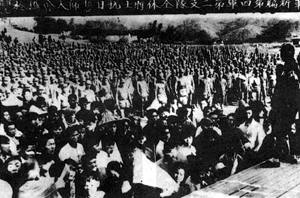Difference between revisions of "New Fourth Army"
imported>Ciic (Created page with 'thumb|300px|right|The New Fourth Army is being mobilized to fight against Japanese aggressors.Following the outbreak of the War of Resistance against Japan i...') |
imported>Ciic |
||
| Line 1: | Line 1: | ||
| − | [[File:xsj.jpg|thumb|300px|right|The New Fourth Army is being mobilized to fight against Japanese aggressors.]]Following the outbreak of the [[War of Resistance against Japan]] in July[[1937]], the Japanese army attacked [[Shanghai]] and threatened China's then capital, [[Nanjing]]. The ruling Nationalist Party – the[[Kuomintang]] (KMT) – was forced to ally with the [[Communist Party of China]] (CPC) to resist the invasion. The two parties agreed that Red Army guerrilla forces in southern [[China]] would be re-organized into a formal army that would operate around the [[Yangtze River]], and in the provinces of [[Fujian]] and [[Zhejiang]]. | + | [[File:xsj.jpg|thumb|300px|right|The New Fourth Army is being mobilized to fight against Japanese aggressors.]] |
| + | Following the outbreak of the [[War of Resistance against Japan]] in July[[1937]], the Japanese army attacked [[Shanghai]] and threatened China's then capital, [[Nanjing]]. The ruling Nationalist Party – the[[Kuomintang]] (KMT) – was forced to ally with the [[Communist Party of China]] (CPC) to resist the invasion. The two parties agreed that Red Army guerrilla forces in southern [[China]] would be re-organized into a formal army that would operate around the [[Yangtze River]], and in the provinces of [[Fujian]] and [[Zhejiang]]. | ||
On [[October 12]], [[1937]], the Military Council of the KMT government formally announced that Red Army guerrillas in the eight provinces of southern China had been reorganized as the '''New Fourth Army''' of the National Revolutionary Army and appointed [[Ye Ting]] as commander. In order to strengthen the role of the CPC in the New Fourth Army, the CPC Central Committee set up a branch of the Central Military Commission inside the New Fourth Army and appointed [[Xiang Ying]] secretary and [[Chen Yi]] deputy secretary. | On [[October 12]], [[1937]], the Military Council of the KMT government formally announced that Red Army guerrillas in the eight provinces of southern China had been reorganized as the '''New Fourth Army''' of the National Revolutionary Army and appointed [[Ye Ting]] as commander. In order to strengthen the role of the CPC in the New Fourth Army, the CPC Central Committee set up a branch of the Central Military Commission inside the New Fourth Army and appointed [[Xiang Ying]] secretary and [[Chen Yi]] deputy secretary. | ||
Latest revision as of 07:36, 11 October 2014
Following the outbreak of the War of Resistance against Japan in July1937, the Japanese army attacked Shanghai and threatened China's then capital, Nanjing. The ruling Nationalist Party – theKuomintang (KMT) – was forced to ally with the Communist Party of China (CPC) to resist the invasion. The two parties agreed that Red Army guerrilla forces in southern China would be re-organized into a formal army that would operate around the Yangtze River, and in the provinces of Fujian and Zhejiang.
On October 12, 1937, the Military Council of the KMT government formally announced that Red Army guerrillas in the eight provinces of southern China had been reorganized as the New Fourth Army of the National Revolutionary Army and appointed Ye Ting as commander. In order to strengthen the role of the CPC in the New Fourth Army, the CPC Central Committee set up a branch of the Central Military Commission inside the New Fourth Army and appointed Xiang Ying secretary and Chen Yi deputy secretary.
On December 25, 1937, the headquarters of the New Fourth Army was formally established in Hankou, and moved to Nanchang on January 6, 1938. The army had roughly 10,000 troops, organized as four detachments and one task force battalion. The New Fourth Army fought heroically against the Japanese aggressors and was noted for its military performance.
